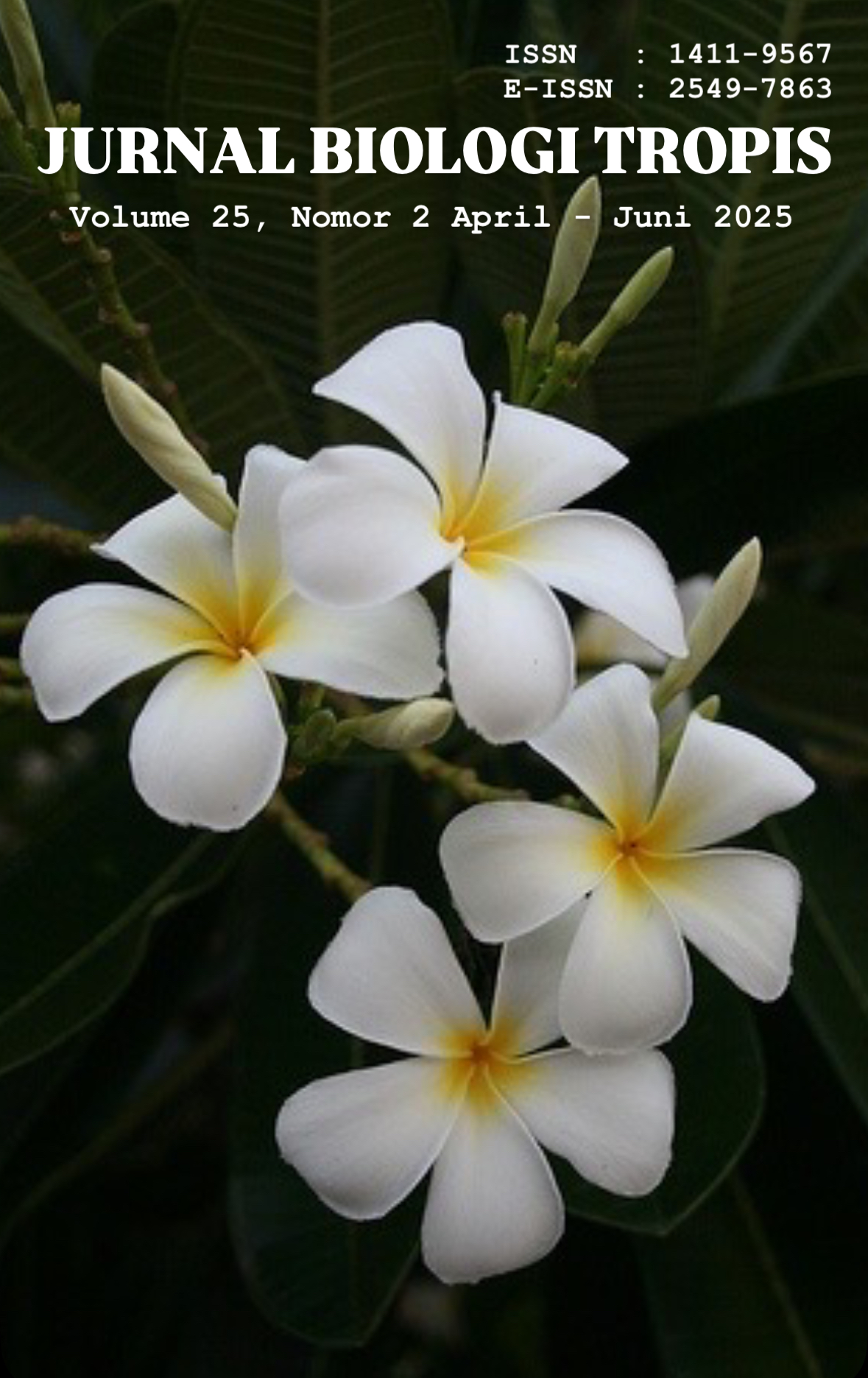Butterfly Species Richness in Different Habitats of Pontianak City, West Kalimantan
Authors
Elpe Bibas , Fitriyan Kurnia , Adityo Raynaldo , Etha Marista , Muftiah Yasi Dwi Wahyuni , Riza LindaDOI:
10.29303/jbt.v25i2.8715Published:
2025-04-21Issue:
Vol. 25 No. 2 (2025): April-JuniKeywords:
Agroforestry, biodiversity, estimates, papilionoidea, urban.Articles
Downloads
How to Cite
Downloads
Metrics
Abstract
Urbanization drives biodiversity loss, but green spaces in Pontianak City may still serve as important refuges for butterflies. This study aims to assess butterfly species richness across different habitat types in Pontianak City, including agricultural, agroforestry, city parks, suburban areas, and marginal lands. Data were collected using the time-constrained counts method with a 30-minute observation period per site. Species richness was estimated using Chao1 estimator, diversity was analyzed with Hill numbers, and species composition was compared using the Chao-Sørensen similarity. A total of 438 individuals from 50 species were recorded. Agroforestry, suburban areas, and city parks exhibited relatively similar levels of species richness (28, 26, and 25 species, respectively), with agroforestry demonstrating the highest species richness and diversity (Shannon = 20, Simpson = 16). Conversely, agricultural areas (14 species) and marginal lands (7 species) showed comparatively lower species richness. The highest estimated species richness was found in city park habitats (36 species). Agricultural and marginal lands had the highest species similarity (0.77), whereas agroforestry and marginal lands had the lowest (0.22). These findings highlight agroforestry, suburban areas, and city parks as key conservation areas for butterflies. Habitat management strategies should prioritize these habitats to support butterfly diversity in Pontianak City.
References
Aguilera, G., Ekroos, J., Persson, A. S., Pettersson, L. B., & Öckinger, E. (2019. Intensive management reduces butterfly diversity over time in urban green spaces. Urban Ecosystems, 22(2). https://doi.org/10.1007/s11252-018-0818-y
Asmah, S., Ghazali, A., Syafiq, M., Yahya, M. S., Peng, T. L., Norhisham, A. R., Puan, C. L., Azhar, B., & Lindenmayer, D. B. (2017). Effects of polyculture and monoculture farming in oil palm smallholdings on tropical fruit-feeding butterfly diversity. Agricultural and Forest Entomology, 19(1). https://doi.org/10.1111/afe.12182
Attiwilli, S., Ravikanthachari, N., & Kunte, K. (2024). A comparison between time-constrained counts and line transects as methods to estimate butterfly diversity and monitor populations in tropical habitats. Insect Conservation and Diversity, 17(1). https://doi.org/10.1111/icad.12693
Barkmann, F., Huemer, P., Tappeiner, U., Tasser, E., & Rüdisser, J. (2023). Standardized butterfly surveys: comparing transect counts and area-time counts in insect monitoring. Biodiversity and Conservation, 32(3). https://doi.org/10.1007/s10531-022-02534-2
Chao, A., Chazdon, R. L., & Shen, T. J. (2005). A new statistical approach for assessing similarity of species composition with incidence and abundance data. Ecology Letters, 8(2). https://doi.org/10.1111/j.1461-0248.2004.00707.x
Chao, A., Gotelli, N. J., Hsieh, T. C., Sander, E. L., Ma, K. H., Colwell, R. K., & Ellison, A. M. (2014). Rarefaction and extrapolation with Hill numbers: A framework for sampling and estimation in species diversity studies. Ecological Monographs, 84(1). https://doi.org/10.1890/13-0133.1
Chao, A., Kubota, Y., Zelený, D., Chiu, C. H., Li, C. F., Kusumoto, B., Yasuhara, M., Thorn, S., Wei, C. L., Costello, M. J., & Colwell, R. K. (2020). Quantifying sample completeness and comparing diversities among assemblages. Ecological Research, 35(2). https://doi.org/10.1111/1440-1703.12102
Checa, M. F., Donoso, D. A., Rodriguez, J., Levy, E., Warren, A., & Willmott, K. (2019). Combining sampling techniques aids monitoring of tropical butterflies. Insect Conservation and Diversity, 12(4). https://doi.org/10.1111/icad.12328
Collier, N., MacKay, D. A., Benkendorff, K., Austin, A. D., & Carthew, S. M. (2006). Butterfly communities in South Australian urban reserves: Estimating abundance and diversity using the Pollard walk. Austral Ecology, 31(2), 282–290. https://doi.org/10.1111/j.1442-9993.2006.01577.x
Colwell, R. K. (2013). EstimateS: Statistical estimation of species richness and shared species from samples (Version 9.1.0). User’s Guide and application. Retrieved from https://viceroy.eeb.uconn.edu/estimates/
Corbet, A. S., & Pendlebury, H. M. 1992. The butterflies of the Malay Peninsula (4th ed.). Malayan Nature Society, Kuala Lumpur. ISBN: 9789839681055, pp: 595
Espeland, M., Breinholt, J., Willmott, K. R., Warren, A. D., Vila, R., Toussaint, E. F. A., Maunsell, S. C., Aduse-Poku, K., Talavera, G., Eastwood, R., Jarzyna, M. A., Guralnick, R., Lohman, D. J., Pierce, N. E., & Kawahara, A. Y. (2018). A Comprehensive and Dated Phylogenomic Analysis of Butterflies. Current Biology, 28(5). https://doi.org/10.1016/j.cub.2018.01.061
Guderjan, L., Habel, J. C., Schröder, B., & Schmitt, T. (2023). Land-use pattern and landscape structure impact butterfly diversity and abundance in organic agroecosystems. Landscape Ecology, 38(11). https://doi.org/10.1007/s10980-023-01731-w
Han, D., Wang, C., Sun, Z., She, J., Yin, L., Bian, Q., & Han, W. (2022). Microhabitat preferences of butterflies in urban parks: Both vegetation structure and resources are decisive. Urban Forestry and Urban Greening, 71. https://doi.org/10.1016/j.ufug.2022.127552
Han, D., Zhang, C., Wang, C., She, J., Sun, Z., Zhao, D., Bian, Q., Han, W., Yin, L., Sun, R., Wang, X., & Cheng, H. (2021). Differences in response of butterfly diversity and species composition in urban parks to land cover and local habitat variables. Forests, 12(2). https://doi.org/10.3390/f12020140
Harmonis, Rahim, A., Hidayat, H. A., Saud, O. R., Wilujeng, M., Sampe, R., Kartika, K. F., Aminudin, & Butar, T. B. (2022). Diversity of butterflies in the tropical wetland of Kayan-Sembakung Delta, North Kalimantan, Indonesia. Biodiversitas, 23(6). https://doi.org/10.13057/biodiv/d230660
Herrmann, J., Buchholz, S., & Theodorou, P. (2023). The degree of urbanisation reduces wild bee and butterfly diversity and alters the patterns of flower-visitation in urban dry grasslands. Scientific Reports, 13(1). https://doi.org/10.1038/s41598-023-29275-8
Lin, Y., Huang, S., Fang, W., Zhao, Y., Huang, Z., Zheng, R., Huang, J., Dong, J., & Fu, W. (2023). Butterfly Communities Vary under Different Urbanization Types in City Parks. Animals, 13(11). https://doi.org/10.3390/ani13111775
Marchant, N. C., Purwanto, A., Harsanto, F. A., Boyd, N. S., Harrison, M. E., & Houlihan, P. R. (2015). “Random-flight” dispersal in tropical fruit-feeding butterflies? High mobility, long lifespans and no home ranges. Ecological Entomology, 40(6). https://doi.org/10.1111/een.12239
Oktaviati, W., Rifanjani, S., & Ardian, H. (2019). Keanekaragaman jenis kupu-kupu (ordo lepidoptera) pada ruang terbuka hijau kota pontianak. Jurnal hutan lestari, 7(1). https://doi.org/10.26418/jhl.v7i1.31001
Panjaitan, R., Drescher, J., Buchori, D., Peggie, D., Harahap, I. S., Scheu, S., & Hidayat, P. (2020). Diversity of butterflies (Lepidoptera) across rainforest transformation systems in Jambi, Sumatra, Indonesia. Biodiversitas, 21(11). https://doi.org/10.13057/biodiv/d211117
Pendl, M., Hussain, R. I., Moser, D., Frank, T., & Drapela, T. (2022). Influences of landscape structure on butterfly diversity in urban private gardens using a citizen science approach. Urban Ecosystems, 25(2). https://doi.org/10.1007/s11252-021-01168-6
Pollard, E. & Yates, T.J. (1993). Monitoring Butterflies for Ecology and Conservation. Chapman & Hall, London. ISBN: 9780412402203, pp: 274.
Robinson, G. S., Phillip R. Ackery, P. R., Kitching, I., Beccaloni, G. W., Luis M. Hernández, L. M. (2023). HOSTS - a Database of the World's Lepidopteran Hostplants [Data set]. Natural History Museum. https://doi.org/10.5519/havt50xw
Rushayati, S. B., & Azahra, S. D. (2024). Beyond concrete jungles: Managing urban green spaces as butterfly hotspot and their implications for ecotourism in Pontianak City, Indonesia. IOP Conference Series: Earth and Environmental Science, 1366(1). https://doi.org/10.1088/1755-1315/1366/1/012026
Rusman, R., Atmowidi, T., & Peggie, D. (2016). Butterflies (Lepidoptera: Papilionoidea) of Mount Sago, West Sumatra: Diversity and Flower Preference. HAYATI Journal of Biosciences, 23(3). https://doi.org/10.1016/j.hjb.2016.12.001
Samatha, B., Bhupathi Rayalu, M., & Janaki Bai, A. (2014). Ecological monophagy in the polyphagous nymphalid butterfly Hypolimnas bolina. Journal of the Entomological Research Society, 16(2), 93–98.
Segre, H., Kleijn, D., Bartomeus, I., WallisDeVries, M. F., de Jong, M., Frank van der Schee, M., Román, J., & Fijen, T. P. M. (2023). Butterflies are not a robust bioindicator for assessing pollinator communities, but floral resources offer a promising way forward. Ecological Indicators, 154. https://doi.org/10.1016/j.ecolind.2023.110842
Seki, Y., Takanami, Y., & Maruyama, K. (1991). Butterflies of Borneo, Vol. 2: Lycaenidae, Hesperiidae (K. Otsuka, Ed.). Tobishima Corporation, Tokyo.
Setyawati, T., Narulita, S., Bahri, I. P., & Raharjo, G. T. (2015). A guide book to invasive alien plant species in Indonesia. Research, Development and Innovation Agency, Ministry of Environment and Forestry, Bogor. ISBN: 9789798452666, pp: 418
Sing, K. W., Luo, J., Wang, W., Jaturas, N., Soga, M., Yang, X., Dong, H., & Wilson, J. J. (2019). Ring roads and urban biodiversity: distribution of butterflies in urban parks in Beijing city and correlations with other indicator species. Scientific Reports, 9(1). https://doi.org/10.1038/s41598-019-43997-8
Stuhldreher, G., & Fartmann, T. (2018). Threatened grassland butterflies as indicators of microclimatic niches along an elevational gradient – Implications for conservation in times of climate change. Ecological Indicators, 94. https://doi.org/10.1016/j.ecolind.2018.06.043
Sumah, A. S. W. (2024). The Insects Visitor on Wild Israeli Grass Flowers (Asystasia gangetica (L.) T. Anderson). Indonesian Journal of Applied Research (IJAR), 5(2), 89–98. https://doi.org/10.30997/ijar.v5i2.484
Toussaint, E. F. A., & Warren, A. D. (2019). A review of red-eye pigmentation and diel activity patterns in skippers (Lepidoptera, Papilionoidea, Hesperiidae). Journal of Natural History, 53(35–36). https://doi.org/10.1080/00222933.2019.1692090
Tzortzakaki, O., Kati, V., Panitsa, M., Tzanatos, E., & Giokas, S. (2019). Butterfly diversity along the urbanization gradient in a densely-built Mediterranean city: Land cover is more decisive than resources in structuring communities. Landscape and Urban Planning, 183. https://doi.org/10.1016/j.landurbplan.2018.11.007
Winarni, N. L., Nuruliawati, Anugra, B. G., Junaid, A. R., Widayanti, S., Aslan, Nugroho, A., Miga, I., Kurniawan, M. B., Liestanti, M., Lutfiani, R. A., & Wulandari, Y. (2023). Can cities provide butterfly-friendly habitats? Biodiversitas, 24(4), 2334–2341. https://doi.org/10.13057/biodiv/d240447
Wittman, J., Stivers, E., & Larsen, K. (2017). Butterfly Surveys are Impacted by Time of Day. Journal of the Lepidopterists’ Society, 71(2). https://doi.org/10.18473/lepi.71i2.a9
License
Copyright (c) 2025 Elpe Bibas, Fitriyan Kurnia, Adityo Raynaldo, Etha Marista, Muftiah Yasi Dwi Wahyuni, Riza Linda

This work is licensed under a Creative Commons Attribution 4.0 International License.

Jurnal Biologi Tropis is licensed under a Creative Commons Attribution 4.0 International License.
The copyright of the received article shall be assigned to the author as the owner of the paper. The intended copyright includes the right to publish the article in various forms (including reprints). The journal maintains the publishing rights to the published articles.
Authors are permitted to disseminate published articles by sharing the link/DOI of the article at the journal. Authors are allowed to use their articles for any legal purposes deemed necessary without written permission from the journal with an acknowledgment of initial publication to this journal.


























